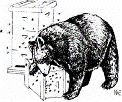Vertebrate Pest Conference: Proceedings

Vertebrate Pest Conference Proceedings: 10th (1982)
Date of this Version
2-23-1982
Document Type
Article
Abstract
The use of snares predates recorded history. The snare was first used when ancient man realized that an association between a tightening loop of vine and an ensnared animal was something which he could construct and repeat. The current increased interest in snares has been a result of restricted chemical tools in animal damage control resulting in a new look at old mechanical methods. The increased value of pelts of predators has brought efforts by private trappers to improve snaring as a tool. As a result, the ancient art of snaring has been greatly improved over the last decade. New snare locking mechanisms, improved snare cables, swivel and holding systems, and placement strategies have resulted in snaring becoming a very useful and reliable method for animal damage control and fur harvest. It has become an efficient alternative for leg-hold traps and M-44s in many situations where weather makes these tools inoperable. The versatility of snares has long been overlooked. They are weather resistant, can be selectively set and located and constructed with break-away devices to protect against holding livestock and nontarget animals. Snares can be set in killing or live-trapping arrangements. The cost of snares is low and maintenance is equivalent to or less than for steel traps. Snares deserve another look as a tool in controlling livestock damage due to coyotes, fox, bobcat, mountain lion, and bear. They can be used on most other problem mammal species as well.

